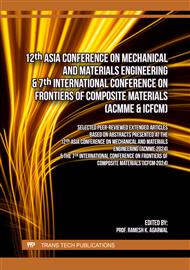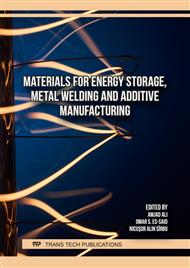p.29
p.41
p.51
p.61
p.69
p.75
p.83
p.93
p.101
Effect of Alloying Elements on Weld Characterization and Wear Resistance of Hardfacing of Structural Steel with Iron-Based Electrodes
Abstract:
The present study is an attempt to provide the solutions to the problem encountered by the components subjected to metal-to-metal wear or galling from grass root level to the advanced stages. Sliding wear or metal to metal wear, galling, can result in seizure due to bonding of the materials and can generate large amounts of damage over small sliding distances. More damage could be expected under unlubricated sliding systems. At lower loads, and particularly at high relative velocities could lead to considerable heating of the metallic surfaces, oxide growth and stripping can also be possibly observed. Under similar conditions cobalt based and nickel based hard facings were considered to be most suited, but due to the high cost of these materials an attempt has been made to achieve adequate hardness and wear resistance at much lower cost, by alloy additions with the help of Shielded Metal Arc Welding (SMAW) process. In this paper the effect of alloying elements on the wear performance of hard-faced components prepared by Shielded Metal Arc Welding (SMAW) process has been undertaken on the low carbon steel substrate by different compositions of iron (Fe) based, hard facing electrodes. The effect of alloying elements especially with varying compositions of chromium and molybdenum on the microstructure, microhardness, and wear resistance of the Fe-based hardfacing alloyed specimens were investigated by means of optical microscopy, and pin on disc wear test. The hardness and wear resistance were improved with the addition of principal alloying elements such as chromium (Cr), molybdenum (Mo) and manganese (Mn) through the consumable electrode during hardfacing by SMAW process. The microhardness of substrate material, i.e., before hardfacing was around 100 HV that latter improved up to 280 HV using first electrode E1, 330 HV using second electrode E2 and 350 HV using third electrode E3. Sliding wear for metal-to-metal wear testing was conducted as per ASTM G99 standards and wear resistance was calculated in terms of the weight loss of the pin after the test run. Wear resistance was found to be improved by 45% approximately with the electrodes E1 and E2 which have chromium content from 2.5% to 4.5 %, whereas an improvement up to 54% was observed with the third electrode E3 corresponding to 6% chromium. The percentage of carbide was found to be more in hardfaced layer in the presence of the molybdenum (Mo). The improvement of hardness and wear resistance of the hardfacing layer is attributed to the solution strengthening of Mo alloying elements. It was further observed that samples that have higher Cr content possessed finer grains with martensitic structure. Role of Mn can also be very important as it removes oxygen and Sulphur from the coatings and improve toughness and overall strength, on the other hand presence of silicon (Si) can attribute to improved yield strength.
Info:
Periodical:
Pages:
69-74
Citation:
Online since:
October 2024
Authors:
Keywords:
Price:
Сopyright:
© 2024 Trans Tech Publications Ltd. All Rights Reserved
Share:
Citation:



